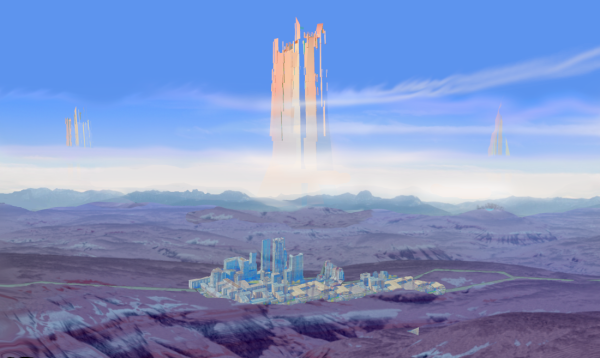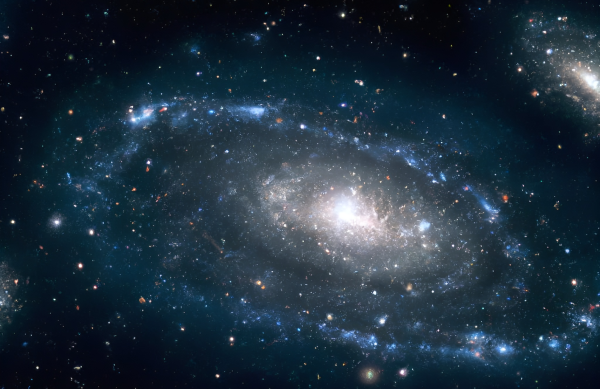BY LETTER
Silent Planetarium
Sophonts > Xenosophonts > Alien Civilisations Outside the Terragen Sphere
Galactography > Cybercosm, The
Galactography > Cybercosm, The
An inhabitable simulation of the universe beyond the Terragen Sphere | |
 Image from Steve Bowers | |
| The simulation of the Golden Tower Builder civilisation in the Andromeda Galaxy is a popular destination for travellers within the Silent Planetarium. A small virtual town has been established on the world AA M 33 - 585 009b, where tourists can observe the enigmatic towers at close hand. | |
The Silent Planetarium is among the many modosophont-accessible universe simulation virchworlds in the Known Net, notable for its focus on objects located beyond the boundaries of the Terragen Sphere. It was originally created in 5685 by the Three Loudnesses of Silent Spheres, a group of aioids inhabiting one of the lesser processing nodes within the Spica system who developed a fascination with objects beyond Terragen reach during the early sixth millennium. In the Current Era, it is maintained by the Rainyard Consortium, one of its few descendant groups that remains attached to the Ril.
The Virchworld
The Silent Planetarium features an expansive recreation of the known universe, including both the observable universe as seen by the Terragen Sphere, and that portion of the universe surrounding the Fargate. The virchworld is populated by simulations of every object remotely observed so far by the Terragens' many telescope arrays, ranging from gigantic galaxies, with all their intricate details, down to tiny asteroids that can be resolved by the powerful astronomical interferometers, out to the limits of the observable universe.Unless specified, users start at a distant location, observing the Milky Way from afar, at the present date. Through various available inputs, ranging from DNI to a mock magical spacecraft capable of superluminal travel, and numerous relevant information sources including guides on locations of interest beyond colonised space, updates on publicly announced interstellar colonisation endeavours, and catalogues of observed vessels travelling out of the Terragen Sphere, they can travel to any location within the known universe. Time within the virchworld runs at the same rate as the Ril by default, but can be sped up, slowed down, reversed, and reset at will. Travelling back in time allows the user to visit the past state of locations now within the Terragen Sphere, while predictions of future events - in the absence of unpredictable sophont activity - can be accessed by moving forward in time (sometimes leading to oddities like the absence of 'unscheduled' spaceflights within distant xenosophont civilisations).
The virchworld is updated constantly. Observational data from various astronomical networks within the Terragen Sphere is gathered, processed, and distributed by automatic algorithms originally developed by the members of the Silent Spheres. By the nature of such observations, there are necessarily gaps in the available information. These gaps are patched by simulations of the future evolution of the various relevant physical systems in play for each object, as well as fictional details at scales too small to be reliably imaged. The Planetarium does contain some data on objects within the Terragen Sphere itself, but these are mere placeholders, incorporating relatively outdated information and rarely updated. Normally, the Terragen Sphere is simply inaccessible; attempts to travel to locations already reached by Terragens result in the user being seamlessly transferred to the Terragen Archive, a similar partnered project managed by the Spica Archivists; the placeholder data becomes possible to visit if the Terragen Archive cannot be found in the local Known Net node.
The Silent Planetarium permits users to interact with other visitors who happen to be at the same location, time, and copy of the Planetarium. They can also communicate with any person active in the same virchworld at the moment, and request to travel to their exact location and time. Users are able to manifest arbitrary objects with any properties they desire, as well as interacting with any of the celestial bodies within the virchworld. Since the 6018 update they can save any of their creations to be restored later, as these changes are reverted once all users depart from the general area. Users may also choose to ignore manifested constructs and objects, a feature that was incorporated in the 6147 update.
Activities
Official Events
For the last three thousand years, the Rainyard Consortium has held official activities which can be accessed by any up-to-date instances of the Silent Planetarium virchworld at an interval of 3^15 seconds (~166 standard days) or its integer multiples. The exact type of event is randomly drawn from a pool of (so far) 157 potential candidates (although the same type of event never appears twice in a row).The first event held is celestial body highlights. Usually lasting for little more than six standard days, it simply announces the identity of the highlighted celestial body, whether it be a garden world, statistically unlikely object, supermassive black hole, or world with aesthetically pleasing views. This serves to raise awareness of the object and increase the likelihood of users traveling there and interacting with other people. After the first few events, the Consortium added optional personal vot guides which appear once the user arrives at the highlighted location.
Other notable official events include Mardtee Drigsoi, which involves mock warfare in various exotic arenas using combat bodies, vehicles, and weapons that employ completely different laws of physics from the Ril. The spectacular and artful, yet effective, display of action in each and every battle made feasible by altered physics typically draws in a large number of spectators, many of whom stay for the entirety of the roughly 14 day event. It also serves as an example of an event adapted from a traditional user-run festival, specifically from the Mang Hugu people of the Mvttogip system.
Unofficial Activities
Activities created by users continue to be an integral part of the cultures of the Silent Planetarium. The Consortium openly endorses these events; with consent from the original developers, it has incorporated several (e.g., the aforementioned Mardtee Drigsoi) into its list of possible official activities.An example of the numerous events which have not yet been incorporated into the list of official events is the Pretty Habitat Design and Build Festival, an event from the Bedanger system where participants create aesthetically pleasing habitats in the same location, which are then evaluated by a large number of judges, including fellow participants, observers, characterbots, or even vots, who may employ any criteria they wish to rate each habitat. Debates and even fights between the judges and builders are exceedingly frequent and are generally regarded as the true highlights of this event.
In many iterations of the Planetarium, societies of sophonts can be found permanently settling in various parts of the virtual universe, including near the Terragen Sphere, on the edge of the observable universe, within unremarkable systems, or around galactic landmarks. A notable example is the Psichit Cube Sculptors, currently a community of 129 million sophonts who settled on an otherwise barren small planet and, through manual manipulation and relocation of one ~177 cubic centimeter (or 1 psichit - a volume measurement unit used by the group) cube at a time over tens of thousands of subjective years, transformed multiple sections of it into angular landscapes criss-crossed with countless canals and waterfalls and populated by pinkish flora.
Related Articles
Appears in Topics
Development Notes
Text by The Astronomer
Initially published on 26 November 2022.
Galaxy image created from components generated in DALL-E AI art software, 2022
Golden Tower Civilization image by Steve Bowers, December 2022
Minor typos fixed, 2024
Initially published on 26 November 2022.
Galaxy image created from components generated in DALL-E AI art software, 2022
Golden Tower Civilization image by Steve Bowers, December 2022
Minor typos fixed, 2024







